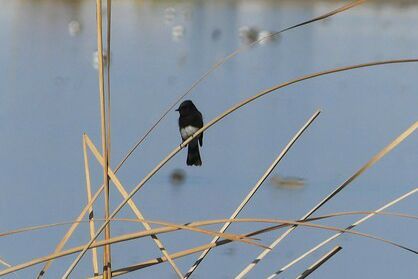Science Corner - Black Phoebe

‘Round about the time that most little kids start learning the sounds that farm animals make (I can still hear the old “See and Say”), my daughter was learning what sounds different birds make. Her first word was turtle so it seemed natural that she would later pursue a biology degree - why not get started early. A little while later, as a biologist’s budding biologist kid, she was learning to identify birds. One species we frequently saw together was the Black Phoebe. I’m not sure why it’s this little bird in particular but every time I see one flitting around I think of her and smile.
Black phoebes (Sayornis nigricans) belong to the flycatcher family (Tyrannidae). With over 400 known species, flycatchers are the largest family of birds in the world. Flycatchers do just as their name implies and fly around erratically in hot aerial pursuit of flies and other winged insects. Black Phoebes are plump, smallish (between the size of a sparrow and a robin) songbirds weighing about a half to three quarters of an ounce and measure a little over six inches long. Our only black flycatcher, they are fashionable little birds with an elegant sooty black and white plumage, a relatively large head with a peaked crown (of course they have a crown!), a straight pointed beak with a tiny hook at the end and long, square-tipped tails. They have predominantly black plumage with a white underbelly that forms an inverted “v” where the black and white join on the lower breast. Males and females look the same and their plumage does not vary by seasons. Juvenile birds look like adults but are white and dark brown which becomes black with age.
Black Phoebes are mainly resident birds in Western United States from Oregon to Mexico, Central America and parts of South America. However, the populations located in higher elevations migrate somewhat with the seasons. They can be found in a variety of habitats including creeks and streams, canyons, farms and urban areas and parks. Black Phoebes often sit conspicuously on exposed perches and branches making short flights to catch insects and then often returning to their perch. They are easy to identify by their persistent tail wagging and bobbing. Black Phoebes have a relatively long breeding season beginning in March lasting through to about August and are typically monogamous with pairs remaining together for five years or more. Courting males will conduct impressive inflight displays that include calling and fluttering nearby where the female is perched. If she plays hard to get and flies away, he will often follow her. Territorial spectacles include tail flaring and fluttering and zig-zagging or spiraling to 100 feet or more in the air and then descending. Males take the female on a tour of potential nest sites and the female chooses the location and does most of the nest building herself. Nests are made primarily of mud mixed with grasses and weeds lined with soft material such as plant fibers, rootlets and hair. They are cup shaped and are anchored somewhere sheltered like the underside of a bridge, the eaves of a building or a protected cliff face. The female lays three to six eggs and only she incubates them. The eggs hatch after about 15 days and are cared for by both parents. Fledging happens in about two to three weeks and usually a pair will have two broods a year using the same nest year after year.
Black Phoebes forage by sitting on a perch and darting out to catch insects in mid-air, sometimes just above the water similar to swallows. They may also hover over plants picking off insects or take them off of the ground. Black Phoebes’ diet consists almost entirely of insects including bees, beetles, crickets, flies, grasshoppers and moths but they will occasionally eat small fish such as minnows or mosquito fish.
Fun Facts
- House Finches invaded an established Black Phoebe nest and both species laid eggs in the same nest. The females took turns incubating the nest with each others eggs for about a week but eventually both of them abandoned the nest.
- The oldest Black Phoebe was over eight years old and was banded and later recaptured in California in the early 80’s.
- Black Phoebes do not use bird boxes but if you provide a nest platform in a safe location you might be lucky enough to have a pair set up house in your yard! move in huge groups to find new berry supplies.
-Kristie Ehrhardt (kehrhardt@tuleyome.org)
Tuleyome Land Conservation Program Manager
RECENT ARTICLES






